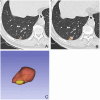Enhancing survival predictions in lung cancer with cystic airspaces: a multimodal approach combining clinical and radiomic features
- PMID: 40276061
- PMCID: PMC12018221
- DOI: 10.3389/fonc.2025.1524212
Enhancing survival predictions in lung cancer with cystic airspaces: a multimodal approach combining clinical and radiomic features
Abstract
Objective: To enhance the prognostic assessment and management of lung cancer with cystic airspaces (LCCA) by integrating temporal clinical and phenotypic dimensions of tumor growth.
Patients and methods: A retrospective analysis was conducted on LCCA patients treated at two hospitals. Clinical and imaging characteristics were analyzed using the independent samples t-test, Mann-Whitney U test, and χ2 test. Features with significant differences were further analyzed using multivariate Cox regression to identify independent prognostic factors. Radiomic features were extracted from CT images, and volume doubling time (VDT) was calculated from two follow-up scans. Separate predictive models were constructed based on radiomic features and VDT. A fusion model integrating radiomic features, VDT, and independent clinical prognostic factors was developed. Model performance was evaluated using receiver operating characteristic curve and the area under the curve, with DeLong's test used for comparison.
Results: A total of 193 patients were included, with an average survival time of 48.5 months. Significant differences were found between survivors and non-survivors in age, smoking status, chronic obstructive pulmonary disease, and tumor volume (P < 0.05). Multivariate Cox analysis identified smoking and chronic obstructive pulmonary disease as independent risk factors (P = 0.028 and P = 0.013). The VDT for survivors was 421 (298 582.5) days compared to 334.5 ± 106.1 days for non-survivors (Z = -3.330, P = 0.001). In the validation set, the area under the curve for the VDT model was 0.805, for the radiomic model 0.717, and for the fusion model 0.895, demonstrating the highest predictive performance (P < 0.05).
Conclusion: Integrating VDT, radiomics, and clinical imaging features into a fusion model improves the accuracy of predicting the five-year survival rate for LCCA patients, enhancing personalized and precise cancer treatment.
Keywords: lung cancer with cystic airspaces; predictive model; radiomics; survival; volume doubling time.
Copyright © 2025 Yin, Wang, Fu, Xing, Liu, Li and Gan.
Conflict of interest statement
The authors declare that the research was conducted in the absence of any commercial or financial relationships that could be construed as a potential conflict of interest.
Figures




Similar articles
-
Integrating CT-based radiomic model with clinical features improves long-term prognostication in high-risk prostate cancer.Front Oncol. 2023 Apr 27;13:1060687. doi: 10.3389/fonc.2023.1060687. eCollection 2023. Front Oncol. 2023. PMID: 37205204 Free PMC article.
-
Volume doubling time and radiomic features predict tumor behavior of screen-detected lung cancers.Cancer Biomark. 2022;33(4):489-501. doi: 10.3233/CBM-210194. Cancer Biomark. 2022. PMID: 35491768 Free PMC article.
-
Novel Non-Invasive Radiomic Signature on CT Scans Predicts Response to Platinum-Based Chemotherapy and Is Prognostic of Overall Survival in Small Cell Lung Cancer.Front Oncol. 2021 Oct 20;11:744724. doi: 10.3389/fonc.2021.744724. eCollection 2021. Front Oncol. 2021. PMID: 34745966 Free PMC article.
-
CT whole lung radiomic nomogram: a potential biomarker for lung function evaluation and identification of COPD.Mil Med Res. 2024 Feb 20;11(1):14. doi: 10.1186/s40779-024-00516-9. Mil Med Res. 2024. PMID: 38374260 Free PMC article.
-
Lung Cancer Associated with Cystic Airspaces: Current Insights into Diagnosis, Pathophysiology, and Treatment Strategies.Cancers (Basel). 2024 Nov 24;16(23):3930. doi: 10.3390/cancers16233930. Cancers (Basel). 2024. PMID: 39682119 Free PMC article. Review.
References
LinkOut - more resources
Full Text Sources

